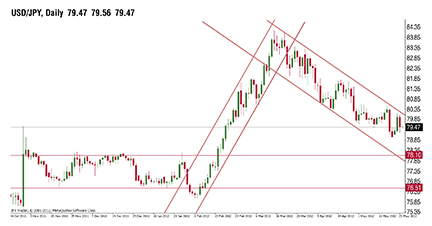TRADING FOREX
The USD/JPY And The EUR/CHF
Profiting From Protracted Consolidations
by Azeez Mustapha
How can a pattern in the USD/JPY indicate what to expect in the EUR/CHF? Find out how you can use it to your advantage.
Most market biases can be summarized by understanding that trading and investing are simple processes and human beings try to make it into something much more complex. In looking at the US dollar/yen (USD/JPY) and the euro/Swiss franc (EUR/CHF) currency pairs, the former had a recent development that could be used as a basis of what was happening in the latter. Here’s something that happened to the USD/JPY and the EUR/CHF, and how it could benefit you.
The USD/JPY consolidation
The dynamics of the markets are a battlefield in which money is transferred from the accounts of novices into those of professionals. On the screen, it may appear not to be a battlefield, since what we see are only candlesticks and bars. During price equilibrium phases, traders open trades and close trades, and the outcomes are not great because the prices are consolidating. Some traders realize minor profits, while others do not realize any.
From October 2011 to January 2012, the USD/JPY pair was in a serious consolidation mode. One market analyst even declared that he would stay out of this market indefinitely. Only short-term traders were able to realize some meaningful gains, not swing or position traders.
As prices change in consolidation modes, there is a tendency to smooth positions prior to reversals. Intraday speculators do not have much time to capitalize on gains. They use the least possible period for trading. As a result, they run losses or decrease their accumulated gains. Intraday speculators would prefer to have opened that kind of position and banked their gains before reversals occurred.
In Figure 1, you can see that two horizontal lines are used to pinpoint where the consolidation on the USD/JPY started and where it ended. On February 14, 2012, the pair broke out of the upper horizontal line and continued moving up on the following day. In fact, this pair moved by more than 500 pips within the following bullish phase before it broke down the lower trendline (you would see two trendlines used to show the bullish trend).

FIGURE 1: RECENT MOVES ON THE USD/JPY. Here we can see that the protracted consolidation that started on the USD/JPY in 2011 resulted in a bullish breakout in February 2012. A peak of 84.17 was reached in March 2012 and the market has been bearish since then.
Excerpted from an article originally published in the September
2012 issue of Technical Analysis of Stocks & Commodities magazine. All rights reserved. © Copyright 2012, Technical Analysis, Inc.
Return to Contents
